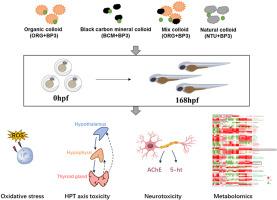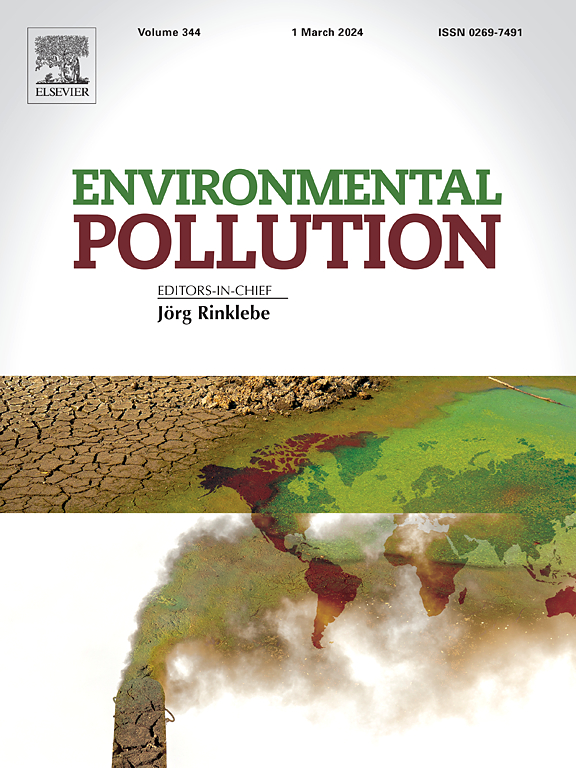Effects of colloids with different compositions on benzophenone-3 biotoxicity in zebrafish embryos
IF 7.6
2区 环境科学与生态学
Q1 ENVIRONMENTAL SCIENCES
引用次数: 0
Abstract
The fate of the pollutants in aquatic environment is closely related to colloids, and the carrier effect of colloids on pollutants not only affects their bioaccumulation, but may also affect their toxicity. In this study, the effects of natural colloid with different components on the biological toxicity of benzophenone-3 (BP3) to zebrafish larvae (Diano rerio) were studied. BP3 caused oxidative stress damage, thyroid system disorders and neurotoxicity in zebrafish larvae. And in the co-exposure groups, the organic and black carbon mineral (BCM) colloids enhanced the organism's antioxidant system by regulating the activities of superoxide dismutase (SOD) and glutathione peroxidase (GPx), reducing the lipid peroxidation damage in larvae. BCM colloids caused the thyroid system disorders in organisms, while organic colloids exacerbated the thyroid toxicity by transporting more BP3 into organisms, inducing severe abnormal heartbeats. The BCM and organic colloids regulated the acetylcholinesterase (AChE) activity and/or 5-hydroxytryptamine (5-ht) contents by affecting the neuroactive ligand receptor interaction pathway in zebrafish larvae, significantly increasing their swimming speed in co-exposure groups under the light condition. In addition, the effects of colloid-bound and freely dissolved BP3 absorbed by organisms on their physiological and biochemical activities were different. By analyzing the relative expression of the significant differential metabolites affected by BP3 in all experimental groups, it was found that colloid-bound and freely dissolved BP3 had a synergistic effect on most of these metabolites and pathways. However, the freely dissolved BP3 interfered with the purine metabolic pathway by mediating 2-(amidino)-n1-(5-phospho-d-ribosyl)acetamidine, and the tyrosine metabolic pathway by mediating choline and uranylacetic acid, while the colloid-bound BP3 has no or inverse regulatory effects on these three metabolites. This study provided a new perspective for the biotoxicity study of the pollutants in aquatic environment, necessitating a reconsideration of the real ecological risks of emerging pollutants in the presence of natural colloids.

不同成分胶体对斑马鱼胚胎二苯甲酮-3生物毒性的影响
污染物在水生环境中的命运与胶体密切相关,胶体对污染物的载体作用不仅影响其生物蓄积,还可能影响其毒性。本研究研究了含不同成分的天然胶体对二苯甲酮-3 (BP3)对斑马鱼幼鱼的生物毒性的影响。BP3引起斑马鱼幼鱼氧化应激损伤、甲状腺系统紊乱和神经毒性。在共暴露组中,有机和黑碳矿物(BCM)胶体通过调节超氧化物歧化酶(SOD)和谷胱甘肽过氧化物酶(GPx)的活性,增强了生物体的抗氧化系统,减轻了幼虫的脂质过氧化损伤。BCM胶体引起机体甲状腺系统紊乱,而有机胶体通过向机体输送更多BP3而加重甲状腺毒性,诱发严重的心跳异常。BCM和有机胶体通过影响神经活性配体-受体相互作用途径调节斑马鱼幼体乙酰胆碱酯酶(AChE)活性和5-羟色胺(5-ht)含量,在光照条件下显著提高了斑马鱼幼体的游泳速度。此外,胶体结合的BP3和自由溶解的BP3被生物体吸收对其生理生化活性的影响是不同的。通过分析各实验组受BP3影响的显著差异代谢物的相对表达,发现胶体结合和自由溶解的BP3对大部分代谢物和途径具有协同作用。然而,自由溶解的BP3通过介导2-(氨基)-n1-(5-磷酸-d-核糖体)乙酰脒干扰嘌呤代谢途径,通过介导胆碱和铀酰乳酸干扰酪氨酸代谢途径,而胶体结合的BP3对这三种代谢物没有或反向调节作用。该研究为水生环境中污染物的生物毒性研究提供了新的视角,需要重新考虑天然胶体存在下新兴污染物的真实生态风险。
本文章由计算机程序翻译,如有差异,请以英文原文为准。
求助全文
约1分钟内获得全文
求助全文
来源期刊

Environmental Pollution
环境科学-环境科学
CiteScore
16.00
自引率
6.70%
发文量
2082
审稿时长
2.9 months
期刊介绍:
Environmental Pollution is an international peer-reviewed journal that publishes high-quality research papers and review articles covering all aspects of environmental pollution and its impacts on ecosystems and human health.
Subject areas include, but are not limited to:
• Sources and occurrences of pollutants that are clearly defined and measured in environmental compartments, food and food-related items, and human bodies;
• Interlinks between contaminant exposure and biological, ecological, and human health effects, including those of climate change;
• Contaminants of emerging concerns (including but not limited to antibiotic resistant microorganisms or genes, microplastics/nanoplastics, electronic wastes, light, and noise) and/or their biological, ecological, or human health effects;
• Laboratory and field studies on the remediation/mitigation of environmental pollution via new techniques and with clear links to biological, ecological, or human health effects;
• Modeling of pollution processes, patterns, or trends that is of clear environmental and/or human health interest;
• New techniques that measure and examine environmental occurrences, transport, behavior, and effects of pollutants within the environment or the laboratory, provided that they can be clearly used to address problems within regional or global environmental compartments.
 求助内容:
求助内容: 应助结果提醒方式:
应助结果提醒方式:


